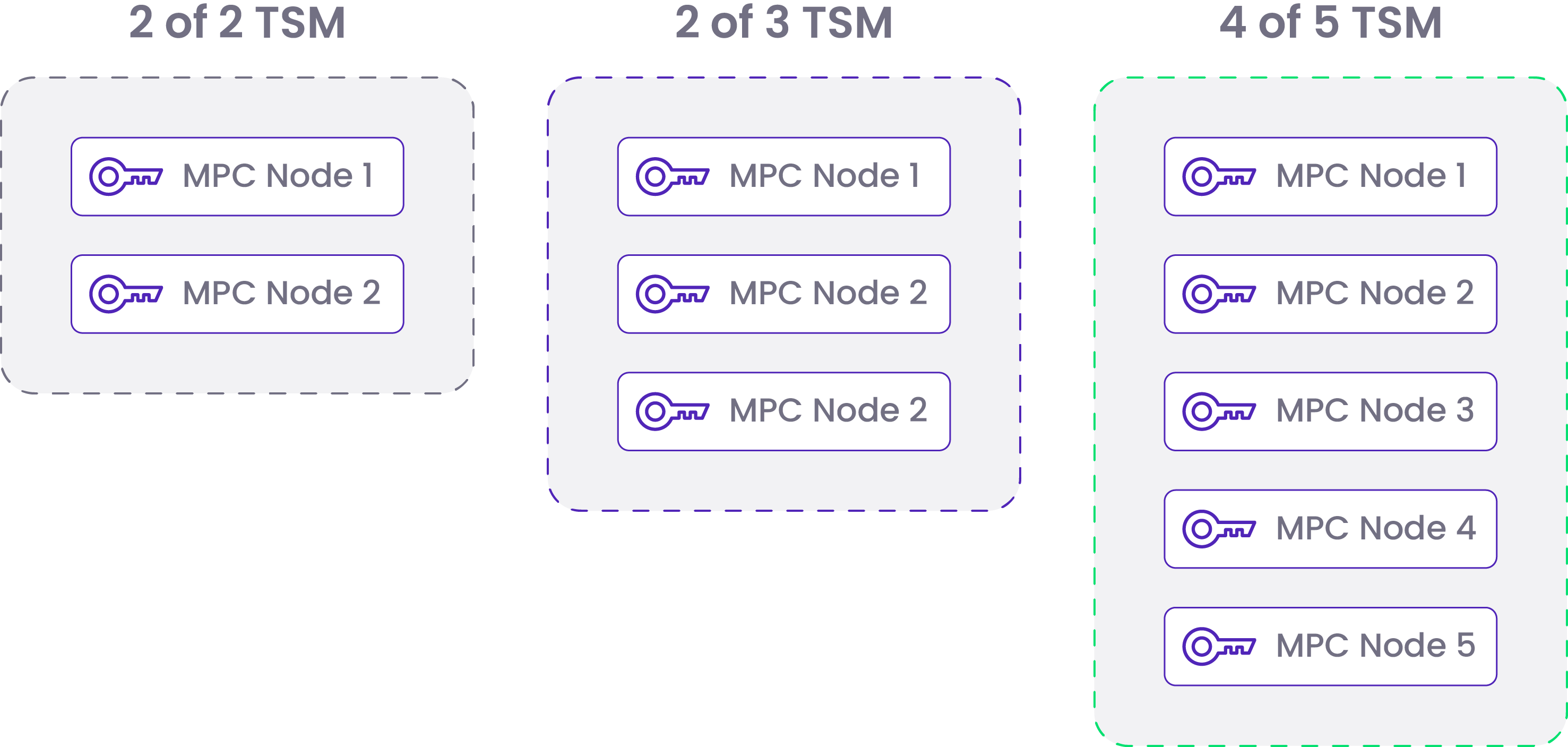Builder Vault Overview
What is Builder Vault TSM?
Builder Vault serves as a threshold security module (TSM) designed for the secure generation, storage, and utilization of cryptographic keys. As a versatile security solution, Builder Vault provides robust key management capabilities adaptable across industries, technologies, and security architectures.
NoteNumerous institutions trust our Builder Vault to enhance wallet security and enable multi-party approval mechanisms called Blockdaemon Advanced MPC.
The following artifacts constitute Builder Vault:
- MPC software that is uploaded to nodes under your control (containers, VMs, or mobile).
- An interconnected set of MPC nodes forms a TSM (Threshold Security Module), with each node responsible for generating and securely storing a portion of the private key.
- SDKs that deliver user-friendly interfaces for seamless integration, efficient administration, and enhanced control.
- A set of n MPC (Multi-Party Computation) nodes, wherein a transaction is collectively signed when approval is obtained from m out of the n participating parties using their respective key shares.
Why use the Blockdaemon Advanced MPC?
Builder Vault Features
Builder Vault TSM presents five key features that make it well-suited for diverse industries, encompassing crypto-accepting payment companies, custodians, as well as Web3 and cryptocurrency foundations.
- Expertise: With over 15 years of MPC experience, we stand unrivaled in the industry, surpassing all vendors in terms of experience.
- Flexibility: When configuring our TSM, you encounter minimal limitations, making it the most flexible option available among vendors.
- Performance: Our TSM boasts an exceptional track record with millisecond-level latency, processing millions of keys in wallets, a feat no other vendor can match in terms of latency and scalability.
- Control: Achieve complete self-hosting capabilities with our TSM, eliminating any dependencies on vendors.
- Secure: Builder Vault places paramount importance on security, employing battle-tested MPC technology designed by leading cryptographers in the field.
These five features collectively solidify Builder Vault as the safest choice, as it harnesses the most established technology and provides unique functionalities unmatched by any other vendors. Additionally, it is developed by Blockdaemon, a prominent blockchain infrastructure provider, adding to its credibility and trustworthiness.
Builder Vault Architecture
Application
The application that you are developing, such as a wallet, which interfaces with the TSM to have transactions signed, when approved.
SDK
The SDK has the capability to independently manage individual MPC nodes, while the User SDK can access and provide approvals. Additionally, the SDK is accessible through multiple programming languages, including JavaScript, Swift, and Golang, offering flexibility and ease of integration.
We provide the following SDKs:
| TSM Node SDK |
|---|
| Go SDK |
| Node SDK |
| Java SDK |
| Mobile SDK (iOS/Android) |
| WASM SDK |
| Native Library SDK |
In addition, we support integrating with Builder Vault via PKCS#11.
ERS Application
An application to recover from a complete system loss or compromise.
NoteThe ERS application is not part of Builder Vault TSM. It only provides an option to create an ERS backup.
MPC Nodes
MPC Nodes are highly versatile and compatible with various computing devices, including iOS, Java VM, Web Assembly, and Docker. You can self-host them in various environments, whether on-premise, in a public or private cloud, or on a mobile platform. MPC nodes serve various essential functions, including:
- Enabling MPC Quorum Approvals
- Key Lifecycle Management (deleting key shares, key resharing)
- Performing Cryptographic Operations
- Supporting MPC Protocols
- Monitoring and Audit Logging
- Key Backup and Recovery
Message Broker
The message broker plays a pivotal role in establishing connections between nodes and offers the flexibility to be hosted independently, separate from the MPC Nodes themselves.
TSM Environment
Builder Vault TSM offers two different environments that can be used when setting up your TSM in a multi-party computation environment:
Static TSM
In a static setup, the number of participating nodes and their configuration remain fixed once the TSM is established. This means that the TSM contains a predetermined number of MPC nodes, and these nodes don't change in number or configuration without significant administrative intervention. This environment has the most alternative support with limited hosting options and a maximum of 1 mobile node per TSM.

Dynamic TSM
A dynamic setup, on the other hand, is more flexible. It allows for nodes to be added or removed from the TSM, and the configuration can change dynamically without disrupting the overall operation of the TSM. A dynamic setup is commonly used in the "Wallet as a Service" (WaaS) model, where the Service Provider (SP) hosts one or more nodes, while the client has the flexibility to host up to one node per TSM. This arrangement allows clients to easily adapt their node configuration based on their specific needs and requirements.
TSM WEB3 Wallet Use Case
In this example, we introduce a WEB3 wallet, designed as a self-custody multi-chain wallet. Below, we provide the architectural diagram used for this specific WEB3 wallet use case.
Utilizing the architecture described above, the WEB3 wallet offers the following advantages and functionalities:
Wallet Service
- No reliance on private keys or seed phrases.
- Noncustodial or self-custody model.
- Accommodates single or multiple mobile nodes or users, enabling:
- Multi-party approval mechanisms.
- Social Recovery options.
TSM-MPC-based Cryptographic Platform
- Proven Advanced MPC with utmost security.
- Scales to 100s millions of users/wallets.
- Blockchain Protocol agnostic (CeFi, DeFi, NFT).
SDK Libraries
- Separates wallets from applications.
- Abstraction of MPC and Cryptography.
- SDK libraries compatible across various platforms.
Updated 3 months ago
